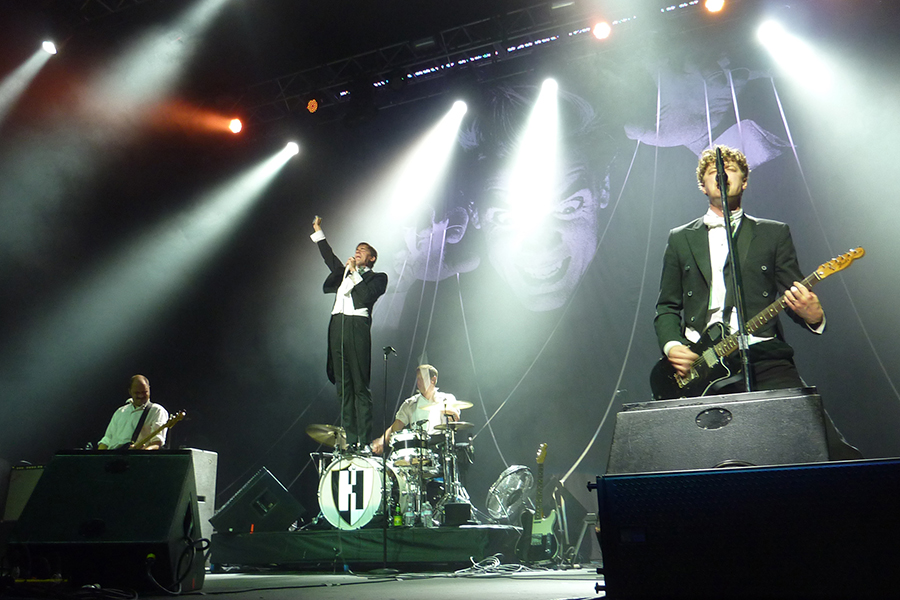Interview: Swedish band the Hives busy as bees with new release

The Hives perform at her Warfield in San Francisco on Sept. 10, 2012. Roman Gokhman/STAFF.
This story originally appeared in the Oakland Tribune.
The five members of garage punk band The Hives gave themselves rock nicknames and credit many of their songs to a man who most likely does not exist. They regularly voice proclamations such as this nugget from guitarist Nicholaus Arson to the BBC:
“If the Beatles could make a ‘White Album’ and Metallica could make a ‘Black Album,’ there was only one band who could make a record twice as good as those two combined.” And that’s despite their previous album selling fewer than everyone’s expectations.
Their latest offering, “The Black and White Album,” is staggeringly different work for The Hives, who play Wednesday at the Fillmore in San Francisco.
The 90-degree turn in output is due not to pressure to increase album sales, but rather to the band’s changing taste, drummer Chris Dangerous said in a recent interview.
“We’ve always had a very set plan: We thought we were going to be a punk band, we were going to make three records, and then we were going to quit,” Dangerous said. “But we figured we had some different music in us.”
The Hives came together in the tiny town of Fagersta, Sweden, in the mid-’90s. They are fronted by Howlin’ Pelle Almqvist (real name: Per Almqvist). The two guitarists are Arson (Niklas Almqvist, the lead singer’s brother) and Vigilante Carlstroem (Mikael Karlsson Astrom). Bassist Dr. Matt Destruction (Mattias Bernvall) and Dangerous (Christian Grahn) complete the band.
They released their first full-length album, “Barely Legal,” in 1997 on a Swedish label. Their second effort, “Veni Vidi Vicious,” followed two years later.
The album yielded the hit single “Hate to Say I Told You So.” In 2001, they switched labels and re-released the song and several others as a compilation, “Your New Favourite Band.” The Hives then signed with Universal Music and re-released “Veni Vidi Vicious” in the United States.
With the newfound success of the album, The Hives became one of “The” big four garage bands, along with The Strokes, The White Stripes and The Vines.
They were the jesters of the bunch. They dressed in matching black-and-white suits; Howlin’ Pelle, never one for understatement, declared to anyone who would listen that they were the hottest band in the world.
Much of the credit went to Randy Fitzsimmons, the probably imaginary manager who discovered the group when its members were teens and wrote many of their songs.
“It’s all true; he, in fact, exists,” Dangerous said. “He’s a sixth member of the band, and he doesn’t do interviews and he’s never been in a picture.”
All right, Dangerous, so what’s his favorite food?
“Probably meatballs, because he’s spent so much time in Sweden.”
“Tyrannosaurus Hives,” the band’s third album, was released in 2004 to lofty expectations. Although it was received well by critics, it sold just
500,000 copies — a disappointment for the group’s record label.
“Selling records these days is probably harder than getting to the top of Mount Everest,” Dangerous said. “We were happy with the record.”
The groundwork for the new album’s direction was set in 2002, when the band members ran into hip-hop producer Pharrell Williams, of The Neptunes, at a festival in Japan.
Williams suggested they work together, Dangerous said, but the time was not right.
“For this record, we didn’t really know what kind of producer to use,” he said. “And then we remembered Pharrell.”
They worked on several tracks together, but the one they were able to finish was the funky, sway-inducing “T.H.E.H.I.V.E.S.,” in which Howlin’ Pelle imitates Prince with a tone that’s not quite falsetto in range.
Their time with Williams opened up the floodgates. Suddenly, they were working with Jacknife Lee (of U2, Editors and R.E.M fame), Timbaland, Dennis Herring (whose credits include Elvis Costello and Modest Mouse) and others.
“We couldn’t decide on one guy so we thought that if we worked with all these people on this record, it could turn out to be very different and very good,” Dangerous said. “We thought of this record as a greatest-hits album.”
It was also their most difficult album to make. In the past, band members would spend countless hours in the studio crafting each song until they all were satisfied.
Each producer they worked with was a polar opposite who would start dozens of songs at the same time to see what worked and what didn’t. Because of that, several songs weren’t finished, including all the ones produced by Timbaland. A dozen more were set aside.
“We’re so picky about everything, and leaving the important decisions to someone else is hard,” Dangerous said. “It was a lot of fun but I’m not sure we could do that again.”
Released in November, “The Black and White Album” was as varied as the producers the band worked with. Besides several traditional garage and punk rock tunes and “T.H.E.H.I.V.E.S.,” songs such as first single “Tick Tick Boom” and “Won’t Be Long” have heavy pop influences. At least one, “Puppet On a String,” must have been inspired by “The Addams Family” theme.
The band fought for eight months over which songs to keep and which ones to drop, Dangerous said.
“We could have done (album) No. 4 the way people expected it to sound, but it wouldn’t be fun,” Dangerous said. “Not for us.”
Follow editor Roman Gokhman at Twitter.com/RomiTheWriter.
